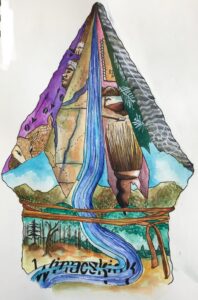Historically, Salmon Hole has been used by humans intermittently for the last 12,000 years. The name “Winooski” comes from the Abenaki word “Winooskiok,” a toponym meaning the land of wild onions. (Also why the City Market Co-op is also called the Onion River Co-op! And why its symbol is an onion!) 
As a spot on the Winooski River only slightly inland from Lake Champlain, it has many important attributes that have helped support human life for a long time. Because of its small bays along the sharp bend in the river, it has important spawning grounds for fish such as salmon, alewives, and shad. This makes it great for fishing, and would allow for fish to safely reproduce and return to Champlain for fishing as well. The area also is also a resource for nuts and berries, and the water attracts animals as well.

Signs protecting sturgeon from fishing, as opposed to other fish that are not protected.
The area around Salmon Hole has also been appealing to humans throughout time because of its location in the Champlain Valley. Valleys sometimes form warmer microclimates, which create a longer, more prolific growing season. Additionally, valleys have extended elevation gradients, resulting in many different resources and a lot of biodiversity in a smaller local space. This has made this part of Vermont attractive for agriculture to this day, but especially in the pre-contact period as a safe, supportive place to stay for people who could not migrate into the mountains.
In my time visiting Salmon Hole, I have seen many people fishing, walking their dogs, and hiking. Salmon Hole is now a park, and so has changed to include trails and trail signs. There is also a dam located here, the Winooski One Dam. According to the Vermont Fish & Wildlife Department, the base of the dam has a great diversity of fish that congregate there throughout the year. However, the dam also does not have fish ladder, which prevents fish from swimming even further upstream to spawn. During our lab this past Monday, we learned that sometimes people would fill baskets of fish and carry them around the dam to help the fish spawn further up.
